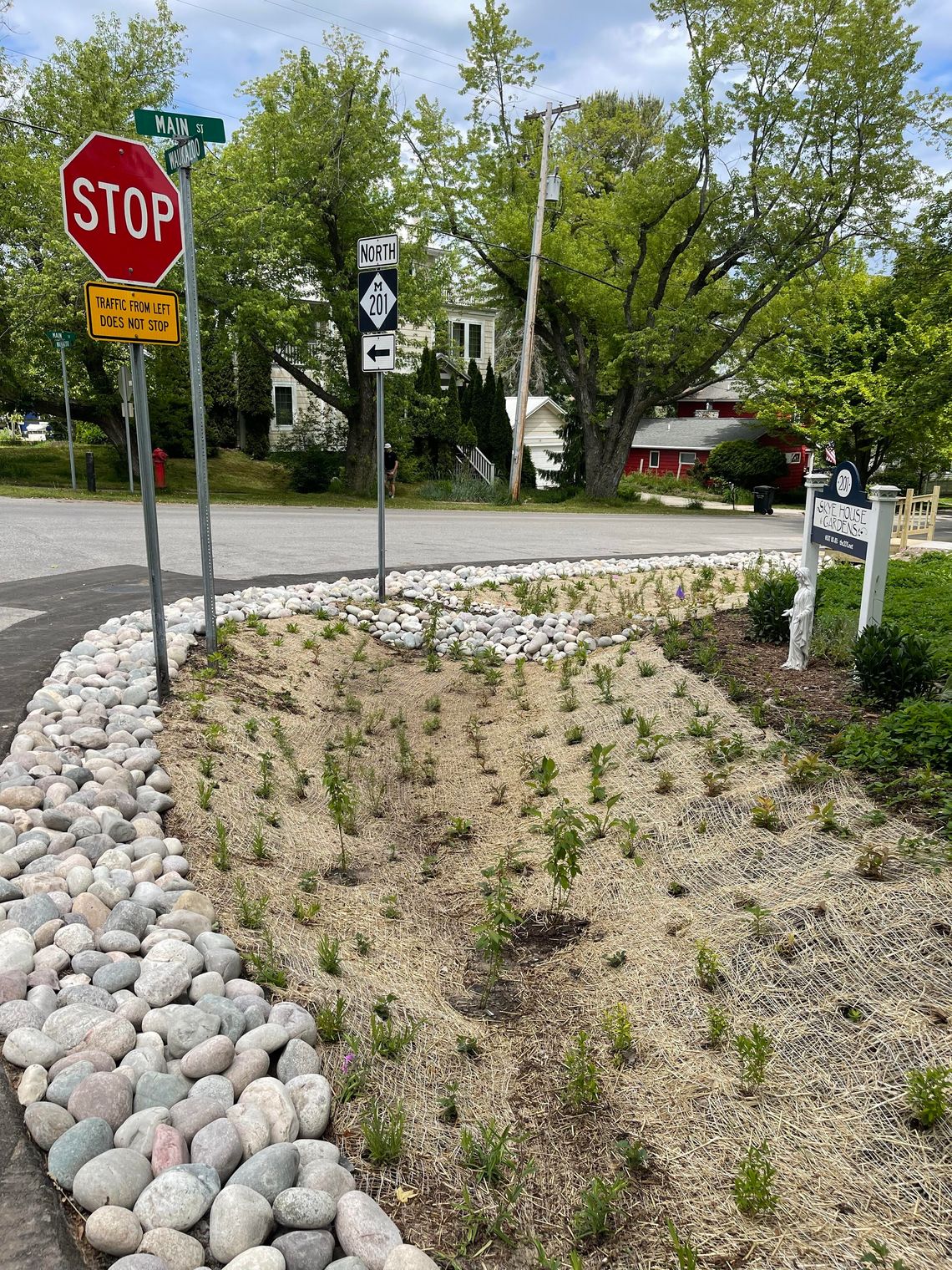The latest rain garden project at the corner of Waukazoo and Main Street in the Village of Northport wrapped up construction last week.
The project was organized by The Watershed Center — Grand Traverse Bay and funded through an EPA (Environmental Protection Agency) grant. It’s also one of several green infrastructure projects completed since 2018 to help reduce village stormwater pollutants that would otherwise drain into Grand Traverse Bay.
“Our goal with this project was to reduce the amount of storm water getting into the drain that negatively affects the beachgoers,” said Sarah U’Ren, program director for The Watershed Center. “As you know, stormwater can contain harmful things like bacteria and other sorts of things that can get into the ground like pesticides, oils, grease… Typically, when we see storm drains next to beaches, we can find high bacteria levels when it rains, so we were concerned about this one because it was right next to the beach where a lot of kids were taking sailing lessons.”
“It’s keeping the bay clean and it looks pretty nice,” said Department of Public Works (DPW) Superintendent Chris Holton, adding that the Northport school parking lot storm drain project has already helped significantly with runoff coming into town. “When it (the Main Street rain garden) fills in and gets all greened up it’s going to be great.”
Big and small green infrastructure projects between the village and Watershed Center have been ongoing over the years. In 2018, The Watershed Center installed a 544 square foot underground infiltration system and six street tree boxes to reduce stormwater runoff along Nagonaba Street. That project alone helps to reduce 1,875,500 gallons of stormwater volume runoff on a yearly basis. The largest installation though is a series of underground infiltration chambers at the Northport Public School parking lot installed last summer. According to the Watershed Center, the rooftop of the school and its main parking area comprise a drainage area of 35,000 square feet, all of which is at the start of the Main Street storm drain. Two smaller rain gardens were also recently constructed in retention areas by the marina parking lot to help with stormwater runoff.
“So an underground infiltration trench just takes the water and puts it in a trench underground and it just soaks it naturally into the ground from there and it doesn’t ever get to the storm drain,” U’Ren explained. “With the same grant, we had funding remaining and we wanted to do a rain garden at the corner of Waukazoo and Main street because we did see a lot of stormwater that was still coming down the hill there.”
Northport Village Manager Jim Dyer said he’s very happy with the completion of the project, adding that it shows how the village is helping to preserve the ecology of the bay.
”We’re appreciative of their (the Watershed Center) willingness to do these projects in Northport and what it contributes to the ecology of the bay,” Dyer said. “They’re really the driving force behind it and we just kind of help the process along by allowing it to be in our property.”
U’Ren said she worked with Greg and Heather Maier, the Northport homeowners that own the land of which the rain garden was constructed, throughout the process. For years, U’Ren said the Maier’s contacted her regarding the installation of a rain garden to help protect water quality, so it was the perfect situation when they had remaining funds from the large project at the high school to go towards the garden.
“They (Greg and Heather) love the bay, they love Northport, and they knew that rain gardens were a great thing to help protect water quality,” she said. “With the remaining funds we were able to partner with those homeowners in the village and put in a rain garden right at that corner. It’s on the village right-of-way property, but the homeowners have pledged to take care of the rain garden and maintain it.”
While not yet in bloom, U’Ren said contractors from Natural Community Services installed native flowers and grasses in the garden such as Equinacea (coneflower), wild lupine, and Dogwood, among many others. The native plants, grasses, and shrubs have a better chance at surviving Michigan’s climate, and their long root systems help in two important ways: Water is absorbed into the rain garden because it follows the path of the roots while it infiltrates the ground, and the root system also takes in the water and filters out some of the pollutants.
“The soil bacteria in the first several inches of the rain garden can actually break down oils and grease, and it can help break down E. coli bacteria. That’s why we really like rain gardens because we let mother nature do the work,” she said. “You can really plant anything you want in a rain garden but we like to use native plants because it’s lower maintenance than if you wanted to plant flowers like petunias or impatiens.”
U’Ren said they did identify other potential places for stormwater projects in the village, but like all of their projects, they are dependent on grant monies and what is available.








